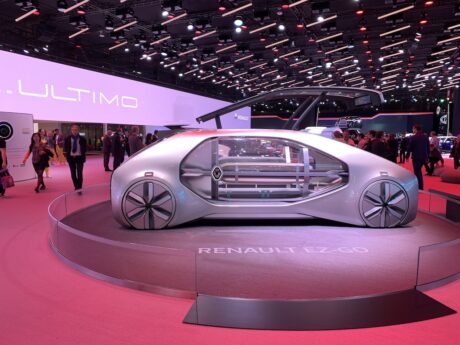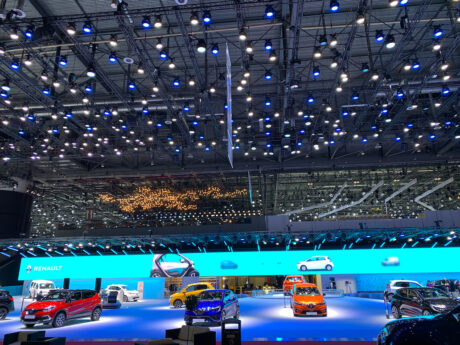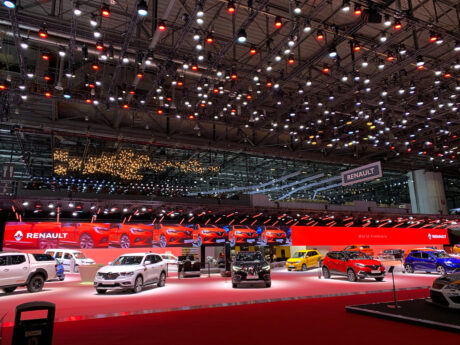
LONDON – When Berlin-based creative event solutions company Pixway helped to create the Renault booth for the 2019 Geneva International Motor Show (GIMS) they utilised four disguise 4x4pro media servers to drive the booth’s massive LED video screen and feed colour information to an innovative interactive lighting rig.
More details from disguise (www.disguise.one):
The annual GIMS is considered one of the most important international auto shows. With the goal of providing show attendees with a look at Renault’s more than 120 years of providing sustainable mobility for all. The booth explored the evolution of the brand, showcased the latest models and engaged show-goers with more than 240 intelligent lights for atmosphere, 109 LED tubes for targeted illumination and a massive LED video screen for maximum visual impact.

A defining element of the booth was the 63 x 2.5-meter LED video screen, with a resolution of 18,144 x 720 pixels. The theme and colours of the video, the speed of the cuts and VFX were all accurately integrated with the programmed lighting creating a real wow-factor.
“We were able to fully showcase how powerful the disguise system is and the benefits the client can achieve by working with the Pixway team operating disguise servers,” says Ron Lindenau, Event Tech and Management Specialist at Pixway.
The project’s contractor, 4Wall Entertainment Group GmbH (formerly Seibo), has worked with Pixway since 2016 on numerous productions featuring immersive experiences, including previous incarnations of the Renault booth such as the 2018 motor show in Geneva as well as other in countries such as China, Russia, Brazil, France, Belgium, just to name a few.
“The booth designers and especially Lighting Designer Christian Jean had a simplistic but powerful vision: a clean booth with high-quality materials and nice shifting natural light that changed according to the video content running on the LED screen,” notes Ron. “It was quite different from a lot of booths where video screens just played loops without affecting the cars showcased.”
The functionality of the disguise pre-vis also played a big part in Pixway being selected for the project. “At the beginning of the planning phase Renault’s main requirement was to find efficient playback systems that could help bring their ideas to life,” says Paul Meffert, Pixway’s CEO.

“The day we arrived at Renault, a few competitors were trying to make their systems run the videos with a canvas size of 18,144px x 720px @ 50fps in QuickTime and lights with over 1,000 Art-Net universes – without success. We got the job the moment we plugged our system into the network and showed them how it played in the disguise pre-viz in real-time. Fast, precise, diverse and reliable were characteristics that Renault deemed essential. We were able to successfully deliver with the disguise system plus our dedicated and skilled Pixway operators being on site to support throughout the event.”
Pixway began working on the project by receiving rig plans, IP tables and Art-Net address tables. “From there, the screens, devices, mappings and outputs were defined, and we were ready for pre-programming with the Lighting Console Operator Philippe Lattoni and Christian Jean,” Paul explains.
The interactive lighting rig was controlled by a lighting console, but they also received color information from the disguise media servers thanks to the use of Luminex LumiNodes and Art-Net signals.

“In Paris, we received the first content for the DMX screens and tested the connections to all the LumiNodes to ensure that all the necessary Art-Net channels we sent our information were working efficiently. Renault was particularly impressed with this part of the process since they had full visibility of their vision throughout programming and on the 3D stage of the disguise GUI. As the core part of the entertainment control system, we sent LTC timecode to the lighting console and to Pro Tools to receive OSC-commands from a Medialon control system.”
disguise’s table screen feature for DMX screens in combination with feed mapping were particularly helpful to Pixway, Ron reports, “They saved a lot of time and gave us flexibility as the content layout changed from show to show.”
Credits:
Technical Producer, Ralph Schrader
Technical Video Planner, Oliver Haupts
Lighting Designer, Christian Jean
Lighting Console Operator, Philippe Lattoni
Lighting System Technician, Roman Schuf
disguise Operator, Paul Meffert, Ron Lindenau
disguise server supplier, programmers and workflow specialists: Pixway GmbH


